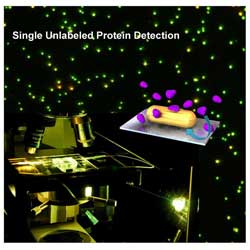Gold nanoantennas detect proteins

The new method developed in Mainz makes it possible to observe individual protein molecules under a microscope with the help of a gold nanoparticle. (diagram: Gold nanoantenna with protein molecules shown in purple)<br>Abb.: Institut für Physikalische Chemie / JGU<br>
Detailed knowledge of the dynamics of proteins is necessary in order to understand the related biological processes that occur on the molecular level. To date, this information has been obtained by means of labeling proteins with fluorescent substances, but unfortunately this changes the proteins under investigation and thus influences the biological processes that are to be observed.
“Our method allows live tracking of individual proteins without having to label them first,” explains Professor Dr. Carsten Sönnichsen of the Institute of Physical Chemistry at JGU. “We are now gaining entirely new insights into molecular processes and can see, for example, how things are constantly in motion even on the very smallest scale.”
The method developed by the group of Mainz chemists led by Carsten Sönnichsen is based on the use of gold nanoparticles. These serve as glistening nanoantennas that, when they detect individual unlabeled proteins, slightly change their frequency or, in other words, their color. These tiny color changes can be observed using the technique developed in Mainz. “This is an enormous leap forward technologically: We have managed to achieve a very high time resolution for the observation of individual molecules,” says Sönnichsen. It is thus now possible to precisely observe the dynamics of a protein molecule down to the millisecond.
The opportunity to detect individual protein molecules also opens up completely new horizons. It has thus become practicable to track the fluctuation of protein population densities and observe protein adsorption processes in real time, among other things. “We can see how molecules move, how they dock at particular locations, and how they fold – this has given us a window into the molecular world,” explains Dr. Irene Ament, a member of Sönnichsen's group. This new technology may prove to be useful not only in chemistry but also in medicine and biology.
The work is an important element in research into non-equilibrium phenomena at the molecular level and thus provides a solid foundation for the planned Cluster of Excellence Molecularly Controlled Non-Equilibrium (MCNE), which has been selected to enter the final round of the Excellence Initiative by the German federal and state governments to promote top-level research at German universities. Among other sources, the project received financial support in the form of an ERC Starting Grant for the project “Single metal nanoparticles as molecular sensors” (SINGLESENS).
Publication:
Irene Ament, Janak Prasad, Andreas Henkel, Sebastian Schmachtel & Carsten Sönnichsen
Single unlabeled protein detection on individual plasmonic nanoparticles
Nano Letters, 23 January 2012
DOI: 10.1021/nl204496g
(see also: http://unibibliografie.ub.uni-mainz.de/opus/frontdoor.php?source_opus=7751)
Media Contact
All latest news from the category: Life Sciences and Chemistry
Articles and reports from the Life Sciences and chemistry area deal with applied and basic research into modern biology, chemistry and human medicine.
Valuable information can be found on a range of life sciences fields including bacteriology, biochemistry, bionics, bioinformatics, biophysics, biotechnology, genetics, geobotany, human biology, marine biology, microbiology, molecular biology, cellular biology, zoology, bioinorganic chemistry, microchemistry and environmental chemistry.
Newest articles

A universal framework for spatial biology
SpatialData is a freely accessible tool to unify and integrate data from different omics technologies accounting for spatial information, which can provide holistic insights into health and disease. Biological processes…

How complex biological processes arise
A $20 million grant from the U.S. National Science Foundation (NSF) will support the establishment and operation of the National Synthesis Center for Emergence in the Molecular and Cellular Sciences (NCEMS) at…

Airborne single-photon lidar system achieves high-resolution 3D imaging
Compact, low-power system opens doors for photon-efficient drone and satellite-based environmental monitoring and mapping. Researchers have developed a compact and lightweight single-photon airborne lidar system that can acquire high-resolution 3D…





















